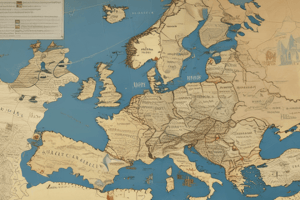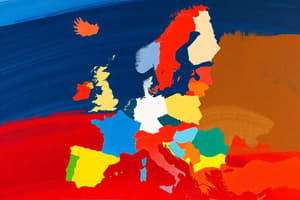Podcast
Questions and Answers
What was the prime concern for Europe in the early post-war period of 1945-50?
What was the prime concern for Europe in the early post-war period of 1945-50?
- How to strengthen nationalism
- How to increase economic competition
- How to promote communism in Europe
- How to avoid another war (correct)
What was the impact of the Marshall Plan in 1948?
What was the impact of the Marshall Plan in 1948?
- It led to the establishment of the European Union
- It facilitated economic recovery through a joint programme (correct)
- It offered financial assistance to promote communism
- It enforced trade barriers among European nations
How did the Organisation for European Economic Cooperation (OEEC) contribute to European integration?
How did the Organisation for European Economic Cooperation (OEEC) contribute to European integration?
- By administering Marshall Plan aid (correct)
- By establishing the European Parliament
- By promoting military alliances
- By creating the European Economic Area
Which countries were the initial members of the European Coal and Steel Community (ECSC) in 1951?
Which countries were the initial members of the European Coal and Steel Community (ECSC) in 1951?
What was a key characteristic of the Cold War impact on Europe?
What was a key characteristic of the Cold War impact on Europe?
Which plan aimed to embed Germany into a European supranational structure post-World War II?
Which plan aimed to embed Germany into a European supranational structure post-World War II?
What was the objective of the European Defence Community (EDC) and the European Political Community (EPC) in the 1950s?
What was the objective of the European Defence Community (EDC) and the European Political Community (EPC) in the 1950s?
Which of the following statements reflects the perspective that prevailed in the late 1940s regarding the cause of war?
Which of the following statements reflects the perspective that prevailed in the late 1940s regarding the cause of war?
What is primarily prohibited to ensure undistorted competition in the EU?
What is primarily prohibited to ensure undistorted competition in the EU?
What began to facilitate the approximation of laws in the European Union?
What began to facilitate the approximation of laws in the European Union?
What significant change regarding leadership and representation in EU policy occurred with the Lisbon Treaty?
What significant change regarding leadership and representation in EU policy occurred with the Lisbon Treaty?
Which of the following does the principle of freedom of movement not apply to?
Which of the following does the principle of freedom of movement not apply to?
Which of the following policy areas was not addressed by the Treaty of Rome?
Which of the following policy areas was not addressed by the Treaty of Rome?
What is the role of the European External Action Service?
What is the role of the European External Action Service?
Which body acts as the executive branch of the EU?
Which body acts as the executive branch of the EU?
What characterizes the 'supranational pillar' in the EU?
What characterizes the 'supranational pillar' in the EU?
What is a primary responsibility of the European Commission?
What is a primary responsibility of the European Commission?
Which institution has direct executive authority in limited areas such as competition within the EU?
Which institution has direct executive authority in limited areas such as competition within the EU?
What is the primary challenge to harmonising social and tax policies in the EU?
What is the primary challenge to harmonising social and tax policies in the EU?
How does the European Commission typically decide on actions?
How does the European Commission typically decide on actions?
What is a crucial power held by the European Parliament regarding the European Commission?
What is a crucial power held by the European Parliament regarding the European Commission?
Which two treaties currently structure the EU as of the 2020s?
Which two treaties currently structure the EU as of the 2020s?
How many people does the European Commission employ approximately?
How many people does the European Commission employ approximately?
What main legislative power does the European Parliament share with the Council of Ministers?
What main legislative power does the European Parliament share with the Council of Ministers?
What percentage of EU legislation is passed under the ordinary legislative procedure?
What percentage of EU legislation is passed under the ordinary legislative procedure?
What is the percentage threshold of member states required to approve a proposal under the QMV system?
What is the percentage threshold of member states required to approve a proposal under the QMV system?
What is the population share percentage that must be represented by the 'yes' voters for a proposal to pass under QMV?
What is the population share percentage that must be represented by the 'yes' voters for a proposal to pass under QMV?
Which budgetary framework defines the maximum spending for EU areas over a 7-year period?
Which budgetary framework defines the maximum spending for EU areas over a 7-year period?
What is the total amount allocated for the 2021-2027 MFF in current prices?
What is the total amount allocated for the 2021-2027 MFF in current prices?
What is the typical expenditure area that represents about 32% of the EU budget?
What is the typical expenditure area that represents about 32% of the EU budget?
Which financial recovery instrument was combined with the MFF after the COVID-19 crisis?
Which financial recovery instrument was combined with the MFF after the COVID-19 crisis?
How does the annual EU budget compare to the public budgets in member states?
How does the annual EU budget compare to the public budgets in member states?
What is a primary reason one-size-fits-all policies are considered inefficient?
What is a primary reason one-size-fits-all policies are considered inefficient?
What are scale economies in the context of centralization?
What are scale economies in the context of centralization?
Which of the following best describes spillovers?
Which of the following best describes spillovers?
How does democracy serve as a control mechanism that supports decentralization?
How does democracy serve as a control mechanism that supports decentralization?
What role does jurisdictional competition play in governance?
What role does jurisdictional competition play in governance?
What might be a consequence of significant externalities within a nation?
What might be a consequence of significant externalities within a nation?
Why are marginal costs described as horizontal in this context?
Why are marginal costs described as horizontal in this context?
What could be a common outcome of decentralizing public services?
What could be a common outcome of decentralizing public services?
Flashcards are hidden until you start studying
Study Notes
European Economy: A Review of EU History, Institutions, and Decision-Making Processes
- Post-WWII Europe faced devastation, prompting a quest to prevent future wars and stabilize the continent.
- Three main schools of thought emerged regarding the causes of war: blame Germany, oppose capitalism, or blame nationalism; the latter led to the idea of European integration.
- The Cold War initiated a division in Europe with rising tensions between the US and USSR, prompting the Marshall Plan for economic recovery in 1948.
- The Marshall Plan provided $12 billion in aid, primarily benefiting the UK, France, and West Germany, administered through the Organisation for European Economic Cooperation (OEEC).
- The European Coal and Steel Community (ECSC) was formed in 1951 with Belgium, France, West Germany, Italy, Netherlands, and Luxembourg to foster economic cooperation.
- Efforts to create the European Defence Community (EDC) and European Political Community (EPC) were unsuccessful.
- Key principles established included the prohibition of state aids, regulation of anti-competitive behavior, and the groundwork for the Single European Act in 1986.
- The Treaty of Rome established the foundations for the Common Agricultural Policy but left social and tax policies largely unregulated and difficult to harmonize.
- The EU architecture is built on two primary treaties: the Treaty on European Union (TEU) and the Treaty on the Functioning of the EU (TFEU).
- EU policies are categorized into supranational (economic-related policies) and intergovernmental (foreign and security policies) pillars.
- Decision-making within the EU involves the European Commission, which proposes legislation, administers policies, and represents the EU internationally.
- The Commission comprises one Commissioner from each member state, operates by consensus, and can be dismissed by the European Parliament.
- The European Parliament shares legislative powers with the Council of Ministers and oversees EU institutions, focusing on efficient and representative policy-making.
- Local governance can lead to inefficiencies due to varying regional needs and preferences; cooperation is critical for addressing externalities.
- Jurisdictional competition incentivizes decentralization, allowing voters to exert influence on local governments through migration.
- Approximately 80% of EU legislation follows the ordinary legislative procedure, where the Council utilizes Qualified Majority Voting (QMV) based on a double majority system.
- The QMV requires approval from at least 55% of member states and representing a minimum of 65% of the EU population for legislation to pass.
- The Multiannual Financial Framework (MFF) for 2021-2027 sets maximum spending limits across the EU budget, focusing on long-term budgetary discipline and predictability.
- The MFF totals €1.211 trillion (€1.074 trillion in 2018 prices) alongside the €806.9 billion recovery instrument, NextGenerationEU, post-COVID-19.
- The EU budget, around €145 billion, constitutes approximately 1% of EU27 GDP, with significant expenditure allocated to agriculture (32%).
Studying That Suits You
Use AI to generate personalized quizzes and flashcards to suit your learning preferences.




